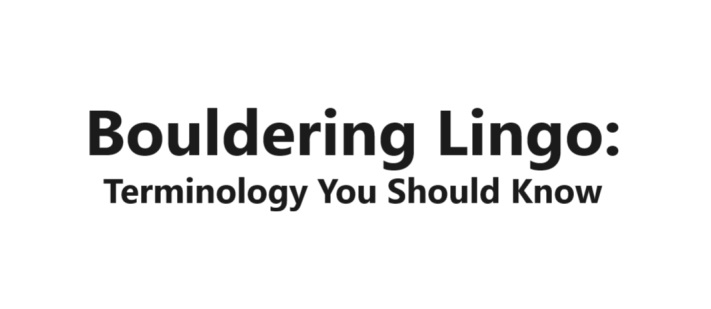What are the bouldering terms you should know? Although you think you can speak English, boulderers tend to have their own lingo that could leave you lost at sea as soon as they start speaking. In the following article, we’ll give you the complete lowdown.
Essential Bouldering Terms You Should Know
Ok. So we will start with the bouldering terms that even a beginner needs to have the grasp of. After that, we will go further into the depths of a boulderer’s vocabulary and you never know what you could find!
Here is the first list of what you could hear at a bouldering hall, gym, or rock:
- Beta: Advice or knowledge on how to climb a problem – usually in the easiest way
- Body Position: The way you place your body in relation the holds on the wall
- Campus: To climb a route without using your feet at all
- Crux: The hardest part of the problem
- Dyno: A jump from one hold to another hold as part of the same problem.
- Flapper: A callus that has been ripped off the hand, leaving a nice bit of hanging skin.
- Flash: To climb the problem on the first try, after seeing someone else do it, or been given the beta.
- Onsight: To climb the problem on the first try with no information or prior knowledge of the climb.
- Problem: A bouldering route. A sequence of holds, with a start and finish.
- Project: A problem that a boulderer is trying to complete, but has yet to do so. Usually, a personal goal to work towards
- Send: To climb a problem without falling off.
- Spot/Spotting: To guide a falling climber safely to the ground.
Bouldering Vocab Relating to Holds and Grip Types
Now you know some of the basic bouldering terms, what about expanding your vocabulary? Sometimes you’ll be on the wall and someone will shout “that looks like a bomber crimp!” What does that even mean?
See our list dedicated to holds and grips below:
- Crimp: A very small edge held onto with your fingertips. A full-crimp uses a bent second finger joint and a thumb pressed onto the index finger.
- Gaston: This involves pushing a hold instead of pulling. A bit like opening patio doors (glass sliding doors) if you were standing in the middle. Named after Gaston Rébuffat.
- Hand Jam: Very rarely used in bouldering. Basically you shove your hand into a crack to fill the hold. There are a number of different techniques associated with this.
- Jug: A hold that is so big you could park a car in it. Or at least enough for you to welp with joy as the hold fills your grasp.
- Pinch: You basically hold the grip between your thumb and fingers. Climbers tend to have really strong pinches.
- Undercling: This is what you do bicep curls for. The hold looks upside down and you need to pull yourself into the wall using body tension and bicep strength.
Other Rock Climbing Terms – Types of Moves
Other types of rock climbing terms that boulderers use are in relation to movements, or types of moves they should be engaging in. Usually, these terms will be used when you are asking how to complete a problem. Note, dyno could be added here, as well as some other terms higher up.
See our list of bouldering terms for moves:
- Deadpoint: Equilibrium. Basically, as you move towards a hold, stop and hit it at the perfect time.
- Flag: Sticking your leg out to improve your balance. Needs fine-tuning or you’ll fall off.
- Heel Hook: Use your heel to pull yourself or keep your self on the wall.
- Kneebar: Our personal favourite. Your foot pressen on the wall whilst your knee/thigh is jammed into an overlapping hold.
- Layback: Not used so much in bouldering. Pull with the hands and push with the feet, usually on a big crack.
- Lock Off: A static reach. Whilst one arm stays motionless, the other reaches for the hold.
- Match: Placing both hands on the same hold at the same time.
- Mantel: If you have ever climbed over a wall when you were a kid, this is the move you did at the top.
- Traversing: Moving laterally along the wall. Not everything goes up!
Climbing Lingo for Outside
When you start going outside, you’ll want the appropriate bouldering vocabulary to go with it. Of course, most of the terms used already can also be used, but the following ones are usually reserved for the outside arena.
See our list for outside climbing terms:
- Choss: Something that gets in the way of a clean rock. Soil, grass, any other kind of debris.
- Crash Pad: The mat used for protection if a climber falls. It’s better to have a few handy.
- Highball: A very high boulder problem. If you fall off, it’s gunna hurt or worse.
Bouldering Vocabulary That No-One Wants to be Associated With
The climbing community is an open and gracious one, but there are some bouldering terms that you don’t want to be associated with.
- Dab: When on a problem, a climber brushes the ground, spotter, another hold, tree, or anything else not associated with the route.
- Spray: To offer beta or tell a climber what to do without being asked beforehand.
Conclusion – There’s Even More Out There!
Although we’ve given you a pretty extensive list of bouldering terms this isn’t the half of it! There are many more out there. Throughout this bouldering hub, we may have even used some that we haven’t listed here!
What do you think? Let us know if we should add any more!

